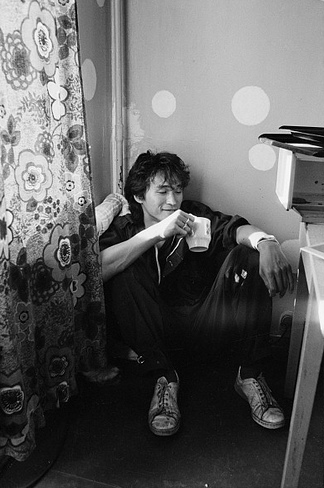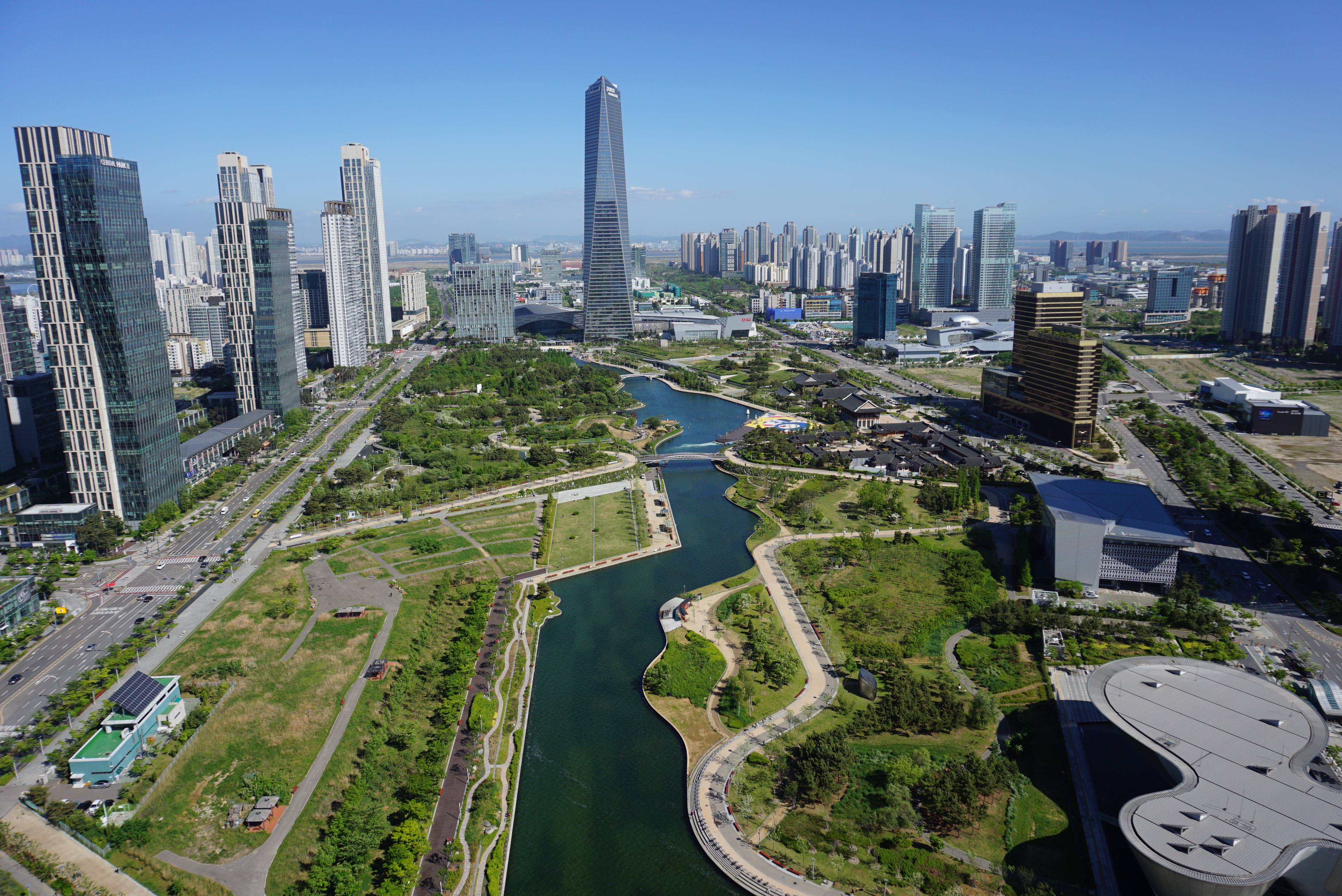|
Hambak Village
Hambak Village (; ) is a neighborhood in Yeonsu District, Incheon, South Korea. It is home to a significant foreign population, and has been called "Russia Town". Description In September 2023, it was reported that 7,400 of 12,000 residents (61.1%) were foreign nationals. Of them, 3,693 are Koryo-saram: ethnic Koreans of the former Soviet Union. There are also 2,135 Kazakhstanis, 1,829 Uzbekistanis, and 260 Kyrgyzstanis. Two elementary schools in the area have more foreign than domestic students. Its residents come from a variety of countries, including Vietnam, China, Russia, Kazakhstan, and Uzbekistan. The cost of living in the area is lower than the surrounding areas and it is in close proximity to Incheon International Airport, which has made it an attractive area for immigrants. Much of the signage in the area is written in Cyrllic script. The area primarily serves lower income residents. The neighborhood has been juxtaposted with the nearby Songdo smart city, which has ... [...More Info...] [...Related Items...] OR: [Wikipedia] [Google] [Baidu] |
Incheon
Incheon is a city located in northwestern South Korea, bordering Seoul and Gyeonggi Province to the east. Inhabited since the Neolithic, Incheon was home to just 4,700 people when it became an international port in 1883. As of February 2020, about 3 million people live in the city, making it South Korea's third-most-populous city after Seoul and Busan. The city's growth has been assured in modern times with the development of its port due to its natural advantages as a coastal city and its proximity to the South Korean capital. It is part of the Seoul Metropolitan Area, along with Seoul itself and Gyeonggi Province, forming the world's fourth-largest List of metropolitan areas by population, metropolitan area by population. Incheon has since led the economic development of South Korea by opening its port to the outside world, ushering in the modernization of South Korea as a center of industrialization. In 2003, the city was designated as South Korea's first free economic zon ... [...More Info...] [...Related Items...] OR: [Wikipedia] [Google] [Baidu] |
Yeonsu District
Yeonsu District () is a district in southern Incheon, South Korea. To the east is Namdong District (Namdong District), on its north border is Nam District (Nam District), and the Yellow Sea is on the west and south sides. Munhak Mountain (Munhak-san) rises in the north, and Seunggi Stream (Seunggi-cheon) flows south to the Yellow Sea. History On March 1, 1995, Yeonsu District annexed part of Nam District. In addition, Yeonsu-1-dong was subdivided into Yeonsu-1-dong and Yeonsu-3-dong, and Dongchun-dong into Dongchun-1-dong and Dongchun-2-dong. On January 1, 1996, Dongchun-2-dong was divided into Dongchun-2-dong and Cheonyang-dong. In 2003, Okyeon-dong was divided into Okyeon-1-dong and Okyeon-2-dong. Cheongnyang-dong was absorbed into Donchun-3-dong. In 2006, Songdo-dong was established and placed under the jurisdiction of Dongchun-2-dong. In 2007, Donchun-2-dong was split into Dongchun-2-dong and Songdo-dong. In 2012, Songdo-dong was split into Songdo-1-dong and Songdo-2-dong. ... [...More Info...] [...Related Items...] OR: [Wikipedia] [Google] [Baidu] |
Koryo-saram
Koryo-saram (; ) or Koryoin () are ethnic Koreans of the post-Soviet states, former Soviet Union, who descend from Koreans that were living in the Russian Far East. Koreans first began settling in the Russian Far East in the late 19th century. Their numbers increased as Koreans fled the Korea under Japanese rule, Japanese colonization of Korea beginning in 1910. A number of Koryo-saram became significant List of Korean independence activists, Korean independence activists, such as Hong Beom-do and Chŏng Sangjin. In 1937, Deportation of Koreans in the Soviet Union, they were all deported to Central Asia. They have since dispersed throughout the former Soviet Union, with significant populations in Siberia, Uzbekistan, and Kazakhstan. Approximately 500,000 Koryo-saram reside in the former Soviet Union, primarily in the now-independent states of Central Asia. There are also large Korean communities in Southern Russia (around Volgograd), the Russian Far East (around Vladivostok), th ... [...More Info...] [...Related Items...] OR: [Wikipedia] [Google] [Baidu] |
Post-Soviet States
The post-Soviet states, also referred to as the former Soviet Union or the former Soviet republics, are the independent sovereign states that emerged/re-emerged from the dissolution of the Soviet Union in 1991. Prior to their independence, they existed as Republics of the Soviet Union, Union Republics, which were the top-level constituents of the Soviet Union. There are 15 post-Soviet states in total: Armenia, Azerbaijan, Belarus, Estonia, Georgia (country), Georgia, Kazakhstan, Kyrgyzstan, Latvia, Lithuania, Moldova, Russia, Tajikistan, Turkmenistan, Ukraine, and Uzbekistan. Each of these countries succeeded their respective Union Republics: the Armenian Soviet Socialist Republic, Armenian SSR, the Azerbaijan Soviet Socialist Republic, Azerbaijan SSR, the Byelorussian Soviet Socialist Republic, Byelorussian SSR, the Estonian Soviet Socialist Republic, Estonian SSR, the Georgian Soviet Socialist Republic, Georgian SSR, the Kazakh Soviet Socialist Republic, Kazakh SSR, the Kirghiz ... [...More Info...] [...Related Items...] OR: [Wikipedia] [Google] [Baidu] |
Incheon International Airport
Incheon International Airport is the main international airport serving Seoul, the capital of South Korea. It is also one of the largest and busiest airports in the world. This airport opened for business on 29 March 2001, to replace the older Gimpo International Airport, which now serves mostly domestic destinations and shuttle flights to several East Asian metropolitan areas, including Beijing Capital International Airport, Beijing–Capital, Kaohsiung International Airport, Kaohsiung, Chubu Centrair International Airport, Nagoya–Centrair, Kansai International Airport, Osaka–Kansai, Shanghai Hongqiao International Airport, Shanghai–Hongqiao, Songshan Airport, Taipei–Songshan and Haneda Airport, Tokyo–Haneda. Incheon International Airport is located west of Incheon's city center, on an artificially created piece of land between Yeongjong and Yongyu Islands. A shallow sea originally separated the two islands. That area between the two islands was reclaimed for the c ... [...More Info...] [...Related Items...] OR: [Wikipedia] [Google] [Baidu] |
Cyrillic Script
The Cyrillic script ( ) is a writing system used for various languages across Eurasia. It is the designated national script in various Slavic languages, Slavic, Turkic languages, Turkic, Mongolic languages, Mongolic, Uralic languages, Uralic, Caucasian languages, Caucasian and Iranian languages, Iranic-speaking countries in Southeastern Europe, Eastern Europe, the Caucasus, Central Asia, North Asia, and East Asia, and used by many other minority languages. , around 250 million people in Eurasia use Cyrillic as the official script for their national languages, with Russia accounting for about half of them. With the accession of Bulgaria to the European Union on 1 January 2007, Cyrillic became the third official script of the Languages of the European Union#Writing systems, European Union, following the Latin script, Latin and Greek alphabet, Greek alphabets. The Early Cyrillic alphabet was developed during the 9th century AD at the Preslav Literary School in the First Bulga ... [...More Info...] [...Related Items...] OR: [Wikipedia] [Google] [Baidu] |
Hankook Ilbo
''Hankook Ilbo'' () is a Korean-language daily newspaper in Seoul, South Korea. As of 2017, it had a daily circulation of about 213,200. It was previously published by the Hankook Ilbo Media Group, however following an embezzlement scandal in 2013–2014 it was sold to Dongwha Enterprise, which also owns ''The Korea Times''. Political position ''Hankook Ilbo'' tends to be economically centre-right and socially centre-left. ''Hankook Ilbo'' is a " liberal" media, but this is different from the meaning of " liberal" in the American political context. ''Hankook Ilbo'' officially doesn't put forward ideology other than "centrism". However, ''Hankook Ilbo'' has basically shown a fiscal conservative tone that values "fiscal responsibility". The newspaper has often criticized the Moon Jae-in government's fiscal policy for its lack of awareness of "financial soundness" (). This newspaper also supports "liberal economy". In contrast to the somewhat conservative tendency financiall ... [...More Info...] [...Related Items...] OR: [Wikipedia] [Google] [Baidu] |
Songdo
Songdo (), officially known as Songdo International Business District (Songdo IBD), is a smart city built on of reclaimed land along Incheon's waterfront, southwest of Seoul, South Korea. It is connected to Incheon International Airport by a reinforced concrete highway bridge called Incheon Bridge. Along with Yeongjong and Cheongna, it is part of the Incheon Free Economic Zone. The Songdo smart city features amenities across the district. Homages of architectural hallmarks, including New York City's Central Park and Venice's waterways, will also be incorporated. Many of the buildings were constructed as LEED-certified space, the green building certification by the United States Green Building Council. Today, Songdo is a community of 167,000 residents located within one of three Free Economic Zones (IFEZ) in Incheon, South Korea. The project has been approximately 86% completed. Aside from residential areas, the location is also home to a Global Campus, Pharma Hub, Startup ... [...More Info...] [...Related Items...] OR: [Wikipedia] [Google] [Baidu] |
Central Asia
Central Asia is a region of Asia consisting of Kazakhstan, Kyrgyzstan, Tajikistan, Turkmenistan, and Uzbekistan. The countries as a group are also colloquially referred to as the "-stans" as all have names ending with the Persian language, Persian suffix "-stan" (meaning ) in both respective native languages and most other languages. The region is bounded by the Caspian Sea to the southwest, European Russia to the northwest, China and Mongolia to the east, Afghanistan and Iran to the south, and Siberia to the north. Together, the five Central Asian countries have a total population of around million. In the pre-Islamic and early Islamic eras ( and earlier) Central Asia was inhabited predominantly by Iranian peoples, populated by Eastern Iranian-speaking Bactrians, Sogdians, Khwarezmian language, Chorasmians, and the semi-nomadic Scythians and Dahae. As the result of Turkic migration, Central Asia also became the homeland for the Kazakhs, Kyrgyzs, Volga Tatars, Tatars, Turkmens, ... [...More Info...] [...Related Items...] OR: [Wikipedia] [Google] [Baidu] |
Closed-circuit Television
Closed-circuit television (CCTV), also known as video surveillance, is the use of closed-circuit television cameras to transmit a signal to a specific place on a limited set of monitors. It differs from broadcast television in that the signal is not openly transmitted, though it may employ point-to-point, point-to-multipoint (P2MP), or mesh wired or wireless links. Even though almost all video cameras fit this definition, the term is most often applied to those used for surveillance in areas that require additional security or ongoing monitoring ( videotelephony is seldom called "CCTV"). The deployment of this technology has facilitated significant growth in state surveillance, a substantial rise in the methods of advanced social monitoring and control, and a host of crime prevention measures throughout the world. Though surveillance of the public using CCTV is common in many areas around the world, video surveillance has generated significant debate about balancing its us ... [...More Info...] [...Related Items...] OR: [Wikipedia] [Google] [Baidu] |
Ethnic Enclaves In South Korea
An ethnicity or ethnic group is a group of people with shared attributes, which they collectively believe to have, and long-term endogamy. Ethnicities share attributes like language, culture, common sets of ancestry, traditions, society, religion, history or social treatment. Ethnicities may also have a narrow or broad spectrum of genetic ancestry, with some groups having mixed genetic ancestry. ''Ethnicity'' is sometimes used interchangeably with ''nation'', particularly in cases of ethnic nationalism. It is also used interchangeably with '' race'' although not all ethnicities identify as racial groups. By way of assimilation, acculturation, amalgamation, language shift, intermarriage, adoption and religious conversion, individuals or groups may over time shift from one ethnic group to another. Ethnic groups may be divided into subgroups or tribes, which over time may become separate ethnic groups themselves due to endogamy or physical isolation from the parent group. Co ... [...More Info...] [...Related Items...] OR: [Wikipedia] [Google] [Baidu] |





